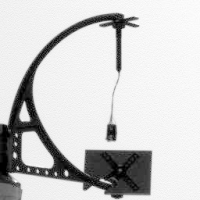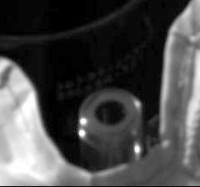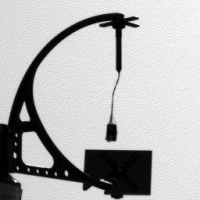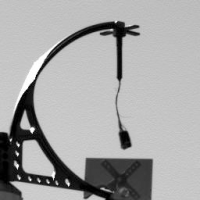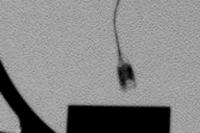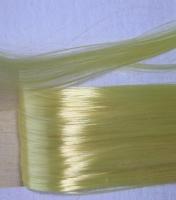Printable Version of Topic
Click here to view this topic in its original format
Unmanned Spaceflight.com _ Phoenix _ MET - Lidar & Telltale
Posted by: Astro0 May 30 2008, 04:54 AM
Windy on Sol 3 between 15:50:08 and 15:55:44 local.
Gamma enhanced to see the image in the mirror.
Enjoy
Astro0
Posted by: Shaka May 30 2008, 05:53 AM
Enjoy
Astro0
OUTSTANDING, Keemosobbee!
So we'd like one of those at least daily, with a weekly 'fast forward' summary.
Of course, the Canucks should really do it (What about it, "Steve G"?).
But if they can't get a round toit, you can hold up The Commonwealth's end.
TIA
Posted by: Deimos May 30 2008, 05:54 AM
Good job. Thought you might like to know the animation is posted (with credit) for the PHX team. We'd normally have made it ourselves ... but the data hit the web long before it hit the SOC. (And I knew if I looked here I could avoid downloading the public data to make it myself.)
Mark
Posted by: djellison May 30 2008, 07:48 AM
Practice what you preach and all that, I'm posting a thread on a sub-element of Phoenix activities.
This movie sequence was on Sol 3- you can see the laser firing, I think.
Posted by: jamescanvin May 30 2008, 08:15 AM
Nice. Well spotted.
EDIT: Posts about MECA (the Microscope) split to a http://www.unmannedspaceflight.com/index.php?showtopic=5186
Posted by: djellison May 30 2008, 09:03 AM
I'm on there, so are Helen and the much missed Suzi.
You're all members of The Planetary Society right. (anyone who says No at this point, hang your head in shame) So all our names should be on there.
Doug
Posted by: PhilCo126 May 30 2008, 02:16 PM
Some background info on this Canadian/Danish experiment on Phoenix Lander
The 350 kg Phoenix Lander carries a meteorological station to measure daily conditions on the arctic pole. The most visible part is a 1.1 meter meteo-mast on the deck of the lander. However an original wind indicator was eliminated from the design, the Canadian Space Agency together with the Aarhus University in Denmark constructed an 8 cm curved device called a “telltale” which holds a tiny wind indicator tube on a short Kevlar string. The telltale is observed by the stereoscopic camera system, aimed at a small mirror under the dangling target, to reveal wind movements.
Thanks again for pointing it out in the photos taken so far!!!
![]()
The other Philip
Posted by: ElkGroveDan May 30 2008, 02:29 PM
You can also see the reflection of the sun moving overhead in the glint along the side of the instrument. Way cool.
Posted by: Airbag May 30 2008, 05:25 PM
Lots of details on the tell-tale at:
http://www.marslab.dk/Filer%20til%20Telltale/TelltaleProjectNews1.htm
I agree with a previous poster in one of the other topics that it looks as if the "kink" in the wire is not how it looked when "new"; perhaps a little damage resulting from the various (planned and designed for) vibrations at launch and landing. Indeed, the "pre launch" image (from the page above) shows what appears to be a straight(er) "wire":
http://www.marslab.dk/Filer%20til%20Telltale/TelltaleATLO.jpg
The tell-tale was basically just dangling free during launch and landing, and was no doubt shaken all over the place!
Airbag
Posted by: ilbasso May 30 2008, 08:43 PM
Is the lower Martian gravity partially an explanation for the wire not being straight? The weight obviously is not pulling as hard against the wire on Mars as it was on Earth. If there were any bias or bend in the wire before it was launched, its effects would be amplified once on Mars.
Posted by: remcook Jun 2 2008, 08:31 PM
yes, I noted that a while back too---the thread seems bend permanently. Not seen a confirmation wherther this is really the case..anyone knows? (sorry, am on holiday, so can't check the forum thoroughly and am not that up to date)
Posted by: Saevar Helgi Jun 5 2008, 10:19 PM
Hi there! My first post here though I've been reading the forum for more than a year. My friend Björn Jónsson told me about this forum some time ago, and I'm always amazed at how knowledgeable everyone here seem to be and also how terrific you are at image processing. I'm a geology student who is going to study planetary sciences in the not so distant future.
Anyway, I sent one scientist I know who's on the Telltale science team, Haraldur Páll Gunnlaugsson at the University of Aarhus, an e-mail in which I asked about the kink. This is his response:
I also asked if the Telltale is offset due to the kink and he said:
He said that the kink has no effects whatsoever. Hope this clarifies something.
*Edited to remove the password protected embedded image link - Helvick.
Posted by: climber Jun 5 2008, 10:35 PM
Welcome on board Saevar Helgi!
Very significant and informative post. Thanks
Posted by: Astro0 Jun 6 2008, 06:37 AM
Windy on Sol11 between 12:31:51 and 12:44:34 local.
Just curious about something. I noticed that the numbers on the Phoenix website for each image and the time noted against each for when they were taken don't seem to follow a logical progression.
eg: Img3207 taken at 12:37:28; Img3208 @ 12:44:34; and Img3213 @ 12:31:51 etc
Weird
Anyone have any ideas?
Astro0
Posted by: antipode Jun 6 2008, 07:05 AM
There seem to be a lot of frayed threads holding up that telltale, it would be embarassing if it blew off at some stage ![]()
P
Posted by: climber Jun 6 2008, 10:04 AM
Telltale caugth in movement : http://phoenix.lpl.arizona.edu/images.php?gID=3206&cID=47
Posted by: elakdawalla Jun 6 2008, 06:39 PM
I noticed the frayed thread too, it's really obvious in the http://planetary.org/data/phoenix/raw/011.html, like this one
I wonder what could have caused that? ![]()
--Emily
Posted by: nprev Jun 6 2008, 06:43 PM
Vibration, normally, presumably during launch. You see the same effects on aircraft flight control cables over time. Swaging the cable ends naturally weakens or even breaks individual strands, and eventually they start to fray. The temp extremes at the landing site will exacerbate the process.
Posted by: Stu Jun 6 2008, 07:19 PM
Hasn't it always been frayed? http://planetary.s3.amazonaws.com/data/phoenix/raw/SS005ESF896651658_10FD0R6M1.jpg pic from Sol 5 suggests a lot of fraying even then...
Posted by: nprev Jun 6 2008, 07:25 PM
Oh, yeah...it's just gonna get worse, though. Hopefully the MET team will take into account the increased surface area exposed to the wind when calculating wind velocities.
Posted by: Stu Jun 6 2008, 07:30 PM
Here's a crop of a Sol 2 pic...
Maybe the much-reported corrosive nature of martian dust is fraying it even more? Stands to reason that if we've seen it blowing then dust is blowing past and through it... countless teeny tiny sharks teeth sawing away at it with each soft whisper of Barsoomian wind...
Edit: interesting pic http://www.nasa.gov/mission_pages/phoenix/multimedia/10721.html... maybe it's not that frayed at the end, after all... some damage up the length of the thread tho...
Posted by: Bill Harris Jun 6 2008, 08:35 PM
>There seem to be a lot of frayed threads holding up that telltale...
What is the telltale thread made of? If it is a Kevlar/aramid tow, then that fraying is not abnormal nor is it serious.
--Bill
Posted by: Airbag Jun 6 2008, 08:52 PM
Kevlar, according to a person in the know a few posts ago. It is not surprising that any damage was already visible right from the start; after all, the tell-tale was never locked in place so must have been thrown around quite a bit during launch and descent (and was tested for those conditions).
Airbag
Posted by: ugordan Jun 6 2008, 09:42 PM
Posted by: Stu Jun 6 2008, 09:43 PM
Genius! ![]()
Posted by: elakdawalla Jun 6 2008, 10:08 PM
Classic. That went straight to the blog. ![]()
Posted by: Pando Jun 7 2008, 05:59 AM
Haha!
(This draws some parallels with teh http://www.bowkera.com/images/Wyoming/Casper%20Friends/WYOWINDSOCK.JPG ![]() )
)
Posted by: Oersted Jun 7 2008, 10:01 AM
What most people don't realise is how extremely light the Tell-tale assembly is: only 20 grams (0.71 ounces). The active part of the Tell-tale, the kapton tube, weighs only an incredible ten-thousandth of a gramme! (0.0001 gramme equal to 0.0000035 ounce). This light weight is necessary to achieve a measurable deflection in the rarified Martian air of only 1 percent Earth sea-level atmospheric pressure.
The kevlar fibers from which the kapton tube is suspended also had to be incredibly light of course, but mainly they had to have some very particular properties. They had to deflect uniformly and steadily, so the wind pressure could be properly read in a single photo. It would be no good if the kevlar fibers just allowed the kapton tube to oscillate randomly.
The famous dust "storms" on Mars only exert a wind force on the back of your hand equal to the force from moving the hand through the air in a slow sweeping motion here on Earth. This was explained by Tell-tale's Islandic team leader Haraldur Páll Gunnlaugsson at the http://www.space-multimedia.nl.eu.org/index.php?option=com_content&task=view&id=3779&Itemid=1. Let's not go into what the Mars atmospheric pressure would do to your hand, if you were to expose it on Mars!
During the first vibration tests - exposing the Tell-tale to the forces of a rocket launch - the instrument failed completely. It took an involved redesign effort to make it comply with the two highly conflicting parameters: sufficiently sensitive to measure the winds on Mars and sufficiently sturdy to survive launch and EDL. But the team succeeded, as we can now see in daily pictures from the surface of the planet!
Tell-tale is the name for http://en.wikipedia.org/wiki/Tell-tale. The University of Aarhus Tell-tale is a deceptively simple-looking instrument, which however took some very clever engineering for it to work properly in the Martian environment. It has already supplied important information about the winds at the Phoenix landing site: we now know that the winds go through 180 degrees from South to North during the Martian day. Important knowledge, because it can be taken into account during digging, so that various samples won't be contaminated by airborne dust from previous digs.
The http://www.au.dk/en in Denmark is my alma mater, so I am very proud to see that it made the Tell-tale on Phoenix! (Aarhus is the second-largest city of Denmark with 250.000 inhabitants. The university is rather new, from the 1920's, and got its first Nobel prize (Jens Chr. Schou, Chemistry) in 1997). Until now it was mainly the Niels Bohr Institute in Copenhagen that made Danish contributions to JPL Mars expeditions, focusing on magnetism. As you may note from my user name, we have quite a tradition in that field (sic..) in Denmark.
The Tell-tale is described more in depth at the Aarhus University Mars Lab page: http://www.marslab.dk/ (sub-page for Tell-tale: http://www.marslab.dk/TelltaleProject.html).
Posted by: imipak Jun 7 2008, 10:57 AM
Oersted, thanks for that very interesting info - it's an excellent example of an experiment that superficially appears utterly trivial, yet becomes both complicated and difficult when you want to do it on Mars.
I guess the light weight of the Kapton tube explains the apparent kink in the "thread"? I can picture a length of string hanging in the air on earth (with nothing hanging on the end) bending at some point along it's length in the wind. In low Mars gravity the tube itself has even less weight to pull the kevlar fibres straight, as the eye might intuitively expect from it's appearance.
Posted by: Bill Harris Jun 7 2008, 12:13 PM
Thanks, Oersted. I had assumed that "telltale" was an informal name for this device, so I didn't search on that keyword. The construction of the device makes sense now. We need something that is very, very light and flexible to detect and measure Martian winds. The Kapton tube (Kapton, BTW, is also used in that ubiquitous orange-yellowish tape on the Rovers and this lander) suspended by Kevlar fibers does just this. The Kevlar tow is composed of thousands of very fine Kevlar fibers and fraying with loose fibers is not unusual with this material. The Kapton tube provides frontal area to react to the wind. Lightness is important since the pendulum moment and frequency has to be very small and very high, respectively. Simple device, yet very complex.
I use Kevlar tow in aircraft wing spars to bind the spar caps and shear webs so they won't burst under flexure. Attached is a photo of the Kevlar tow.
--Bill
Posted by: PFK Jun 8 2008, 08:32 PM
You see that's what I like about this place, you get info like Oersted's on something you really hadn't thought about before - you really can learn something new every day!
Posted by: Oersted Jun 8 2008, 10:38 PM
You're welcome!
I just did a back-of-the-envelope calculation that I can hardly believe:
If we imagined scaling up the kapton cylinder to the size of the famous NASA Vehicle Assemble Building, the VAB, at Cape Kennedy, it would weigh..... 0.0016 kilograms, equal to 0.0564383 ounce!!!
I am calculating with the cylinder being 1 cm. long. The VAB is 160 meters high. Could somebody try to check my result, as I said I can hardly believe it myself...
Posted by: ugordan Jun 8 2008, 10:45 PM
I think you need to cube the scale size to get the mass difference, I get 410 tons for a scaled up version the height of VAB. This, of course, holds only if you scale it in all 3 dimensions equally. If you're only lengthening it, then your result holds.
Posted by: CosmicRocker Jun 9 2008, 06:16 AM
I am certain this telltale experiment was independentaly concieved, but I'd like to note that we previously suggested http://www.unmannedspaceflight.com/index.php?s=&showtopic=3199&view=findpost&p=74643 that a Martian telltale experiment need only have a minimal footprint on a future Mars mission.
Posted by: Deimos Jun 9 2008, 07:23 AM
Yes, by the time of that post the telltale had already been built and failed a couple times, proving how complex simple experiments in extreme environments can be. I believe the genesis of the experiment design involved having someone who modeled airflow over the deck and its impact on delivery, someone with a sailing background and an instrument sensitive to winds (TECP), a couple people involved with IMP and imaging the pathfinder windsock, and of course someone from Denmark--all on the same telecon at the right time. (Take that with a grain of salt--my recollection of anything more than 3 sols ago is a bit hazy at the moment ;^) .)
Posted by: Oersted Jun 9 2008, 09:27 AM
No, no, you're right, it should be scaled in all three dimensions. 410 tons? - That's a lot, what was your calculation, if I may ask?
I'm a mathematically useless "humanist" myself.... But afflicted with a passion for the natural sciences...
Posted by: ugordan Jun 9 2008, 10:46 AM
I used the mass of the telltale: 0.0001 g and multiplied it by the (160/0.01)^3. That gives the above result. Seems a bit too much for me, too. For a fun comparison, I found out that the dry weight of a Saturn V is 250 tons.
Posted by: nprev Jun 9 2008, 03:48 PM
Agreed. It's not gonna fall off, at least for the duration of the mission. Might skew the wind obs just a teeny bit, but not enough to really matter.
Posted by: PFK Jun 9 2008, 09:45 PM
It can happen! Last year I wrote an article in the RSC's Chemistry World magazine asking people to speculate on the following question: "Imagine all the sodium chloride in all the world's oceans crystallised into one enormous prismatic salt crystal with a 1cm x 1cm base. How long/tall would it be?".
I then provided the scarcely believable answer - 20,000 light years!
Powered by Invision Power Board (http://www.invisionboard.com)
© Invision Power Services (http://www.invisionpower.com)
